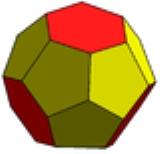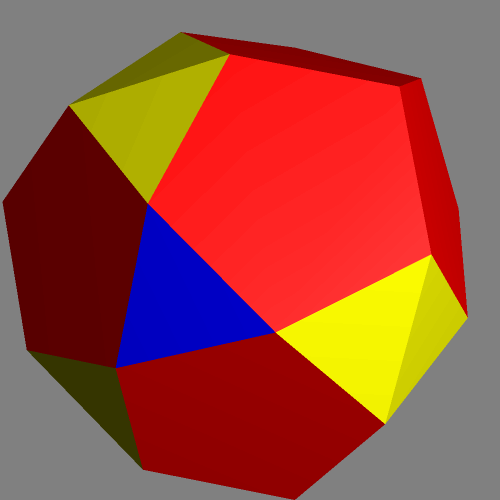
Near-miss Johnson solid
Encyclopedia
In geometry
, a near-miss Johnson solid is a strictly convex
polyhedron
, where every face is a regular or nearly regular polygon
, and excluding the 5 Platonic solid
s, the 13 Archimedean solid
s, the infinite set of prism
s, the infinite set of antiprism
s, and the 92 Johnson solid
s.
The set of near-misses is not exactly defined, but can be loosely defined as convex polyhedra that can be approximately constructed from rigid regular polygon faces as a physical model. Because of the "fuzziness" of this definition, the exact number of near-misses is not known.
s that they can use, defined by a positive angle defect
. A secondary constraint for the triples requires the angle sum of the two smaller polygons to exceed the angle of the larger one.
The set of polygons that can create convex vertex figures include:
NOTE:
Permutation
s of these polygon lists further extend possible vertex figures.
Each vertex figure has an angle defect, and a convex polyhedron will have a combined angle defect of 720 degrees.
These vertex figures and angle defect sums constrain the possible existence of convex polyhedra of regular or near regular polygon faces.
See Vertex configuration for the convex vertex figures used in the regular and semiregular solids.
Geometry
Geometry arose as the field of knowledge dealing with spatial relationships. Geometry was one of the two fields of pre-modern mathematics, the other being the study of numbers ....
, a near-miss Johnson solid is a strictly convex
Convex set
In Euclidean space, an object is convex if for every pair of points within the object, every point on the straight line segment that joins them is also within the object...
polyhedron
Polyhedron
In elementary geometry a polyhedron is a geometric solid in three dimensions with flat faces and straight edges...
, where every face is a regular or nearly regular polygon
Regular polygon
A regular polygon is a polygon that is equiangular and equilateral . Regular polygons may be convex or star.-General properties:...
, and excluding the 5 Platonic solid
Platonic solid
In geometry, a Platonic solid is a convex polyhedron that is regular, in the sense of a regular polygon. Specifically, the faces of a Platonic solid are congruent regular polygons, with the same number of faces meeting at each vertex; thus, all its edges are congruent, as are its vertices and...
s, the 13 Archimedean solid
Archimedean solid
In geometry an Archimedean solid is a highly symmetric, semi-regular convex polyhedron composed of two or more types of regular polygons meeting in identical vertices...
s, the infinite set of prism
Prism (geometry)
In geometry, a prism is a polyhedron with an n-sided polygonal base, a translated copy , and n other faces joining corresponding sides of the two bases. All cross-sections parallel to the base faces are the same. Prisms are named for their base, so a prism with a pentagonal base is called a...
s, the infinite set of antiprism
Antiprism
In geometry, an n-sided antiprism is a polyhedron composed of two parallel copies of some particular n-sided polygon, connected by an alternating band of triangles...
s, and the 92 Johnson solid
Johnson solid
In geometry, a Johnson solid is a strictly convex polyhedron, each face of which is a regular polygon, but which is not uniform, i.e., not a Platonic solid, Archimedean solid, prism or antiprism. There is no requirement that each face must be the same polygon, or that the same polygons join around...
s.
The set of near-misses is not exactly defined, but can be loosely defined as convex polyhedra that can be approximately constructed from rigid regular polygon faces as a physical model. Because of the "fuzziness" of this definition, the exact number of near-misses is not known.
Examples
These four convex polyhedra can be modelled physically with regular polygon faces with various degrees of adjustment. If they could be built exactly, they would be Johnson solids.| Name | Image | verfs Vertex figure In geometry a vertex figure is, broadly speaking, the figure exposed when a corner of a polyhedron or polytope is sliced off.-Definitions - theme and variations:... |
V | E | F | F3 | F4 | F5 | F6 | F8 | F10 | Symmetry |
|---|---|---|---|---|---|---|---|---|---|---|---|---|
| Truncated triakis tetrahedron Truncated triakis tetrahedron The truncated triakis tetrahedron is a convex polyhedron with 16 faces: 4 sets of 3 pentagons arranged in a tetrahedral arrangement, with 4 hexagons in the gaps. It is constructed from taking a triakis tetrahedron by truncating the order-6 vertices... |
 |
4 (5.5.5) 24 (5.5.6) |
28 | 42 | 16 | 12 | 4 | Td | ||||
| -- |  |
6 (5.5.5) 9 (3.5.3.5) 12 (3.3.5.5) |
27 | 51 | 26 | 14 | 12 | D3h | ||||
| Tetrated dodecahedron Tetrated dodecahedron The tetrated dodecahedron is a near-miss Johnson solid. It was first discovered in 2002 by Alex Doskey. It was then independently rediscovered in 2003 and named by Robert Austin.... |
 |
4 (5.5.5) 12 (3.5.3.5) 12 (3.3.5.5) |
28 | 54 | 28 | 16 | 12 | Td | ||||
| -- |  |
12 (5.5.6) 6 (3.5.3.5) 12 (3.3.5.5) |
30 | 54 | 26 | 12 | 12 | 2 | D6h |
Possible vertex figures
The near-misses, like all convex polyhedra made of regular polygons, have a countably infinite set of vertex figureVertex figure
In geometry a vertex figure is, broadly speaking, the figure exposed when a corner of a polyhedron or polytope is sliced off.-Definitions - theme and variations:...
s that they can use, defined by a positive angle defect
Defect (geometry)
In geometry, the defect means the failure of some angles to add up to the expected amount of 360° or 180°, when such angles in the plane would...
. A secondary constraint for the triples requires the angle sum of the two smaller polygons to exceed the angle of the larger one.
The set of polygons that can create convex vertex figures include:
- Triples p.q.r:
- 3.3.(3-5), 3.4.(4-11), 3.5.(5-7), 3.6.(6+), 3.7.(7-41), 3.8.(8-23), 3.9.(9-17), 3.10.(10-14), 3.11.(11-13), 4.4.(4+), 4.5.(5-19), 4.6.(6-11), 4.7.(7-9), 5.5.(5-9), 5.6.(6-7).
- Quadruples p.q.r.s:
- 3.3.3.(3+), 3.3.4.(4-11), 3.3.5.(5-7), 3.4.4.(4-5)
- Quintuples p.q.r.s.t:
- 3.3.3.3.(3-5)
NOTE:
- (a-b) means any polygon for which the number of sides is between a and b inclusive.
- (n+) means any polygon with n or more sides.
Permutation
Permutation
In mathematics, the notion of permutation is used with several slightly different meanings, all related to the act of permuting objects or values. Informally, a permutation of a set of objects is an arrangement of those objects into a particular order...
s of these polygon lists further extend possible vertex figures.
Each vertex figure has an angle defect, and a convex polyhedron will have a combined angle defect of 720 degrees.
These vertex figures and angle defect sums constrain the possible existence of convex polyhedra of regular or near regular polygon faces.
See Vertex configuration for the convex vertex figures used in the regular and semiregular solids.
See also
- Platonic solidPlatonic solidIn geometry, a Platonic solid is a convex polyhedron that is regular, in the sense of a regular polygon. Specifically, the faces of a Platonic solid are congruent regular polygons, with the same number of faces meeting at each vertex; thus, all its edges are congruent, as are its vertices and...
- Semiregular polyhedronSemiregular polyhedronThe term semiregular polyhedron is used variously by different authors.In its original definition, it is a polyhedron with regular faces and a symmetry group which is transitive on its vertices, which is more commonly referred to today as a uniform polyhedron...
- Archimedean solidArchimedean solidIn geometry an Archimedean solid is a highly symmetric, semi-regular convex polyhedron composed of two or more types of regular polygons meeting in identical vertices...
- prismPrism (geometry)In geometry, a prism is a polyhedron with an n-sided polygonal base, a translated copy , and n other faces joining corresponding sides of the two bases. All cross-sections parallel to the base faces are the same. Prisms are named for their base, so a prism with a pentagonal base is called a...
- antiprismAntiprismIn geometry, an n-sided antiprism is a polyhedron composed of two parallel copies of some particular n-sided polygon, connected by an alternating band of triangles...
- Archimedean solid
- Johnson solids
- Geodesic domeGeodesic domeA geodesic dome is a spherical or partial-spherical shell structure or lattice shell based on a network of great circles on the surface of a sphere. The geodesics intersect to form triangular elements that have local triangular rigidity and also distribute the stress across the structure. When...
- Truncated rhombic dodecahedronTruncated rhombic dodecahedronThe truncated rhombic dodecahedron is a convex polyhedron constructed from the rhombic dodecahedron by truncating the 6 vertices.The 6 vertices are truncated such that all edges are equal length. The original 12 rhombic faces become flattened hexagons, and the truncated vertices become squares.The...

